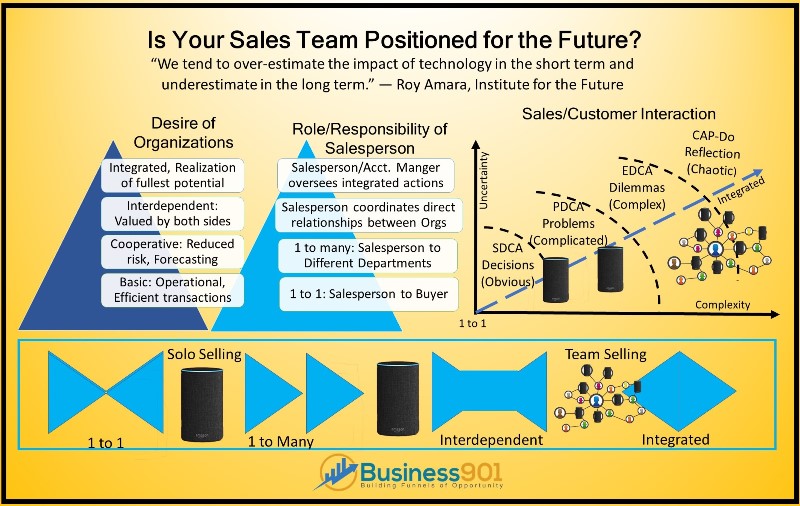What is not distributed now will become distributed. – Unknown
If we believe the above statement, what will our sales force look like in the future? How will it be distributed? William Gibson is credited with the well-known saying, “The future is already here – it’s just not evenly distributed.” I would attest that our present sales efforts in most instances are to create an integrated sales force. In a past blog post, Issues in Transitioning to a Lean Sales Environment, I described how most of us aspire with Key Accounts to move from that initial one to one selling to a more interdependent sales process and even with select accounts an integrated system. This has been the backbone of any Key Account Management (KAM) program. The team selling concept is highly touted in Lean and Agile circles disguised in the terms like cooperation, co-creation, and the idea of dealing with complexity.
There is another component to integrated selling that is accelerating quickly. It is the idea that problem-solving has been commoditized. It is an idea that has been widely spread with a great deal of research. A few examples:
- Dan Pink aspires to this thinking in his book, To Sell is Human that problem-solving has been commoditized. It is a new ABC of Attunement (Seeing – from other’s perspective, Buoyancy – Resilience, Clarity – moving from problem-solving to problem-finding).
- Matt Dixon in the Challenger series of books demonstrates the reactive problem-solving salespeople are at best average. It is the Challenger that goes deeper and extends themselves deeper into a customer’s business.
- In fact, there is a current myth that a salesperson is not invited to the table till 60% of the decision process is already completed. In fact, the likelihood that no-decision will be made and a customer will remain in the current state seems to be increasing.
Most customers know how to solve their problems. It is the deeper understanding of the customer business that we achieve through the methods of PDCA and EDCA. We are exploring opportunities and helping the customer become more efficient or create better opportunities. If you are there to tell the customer that 1 + 1 = 2, you are there responding to a request for a proposal and nothing more. You might as well be a clerk. One of the most important characteristics of the successful salesperson today is the ability to facilitate the group decision making of a customer and his own company in the integrated model. As decision-making is commoditized there will be a rapid increase in artificial intelligence to replace the solo selling of yesteryear. We seemingly are already there with many of today’s Saas Products. It is the area of dilemmas that is the area for successful salespeople.
What is happening in the world of sales is that we are on the edge (or maybe already there) of a collaborative way of selling. We no longer can just sell to a customer; we have to understand our customer’s business and our customer’s customer’s business. The only way that I believe possible is if we are participating at the point of use of our product or service (Lean Thinking with Service Dominant Logic).
How long before we get there? Or, are we already there?

